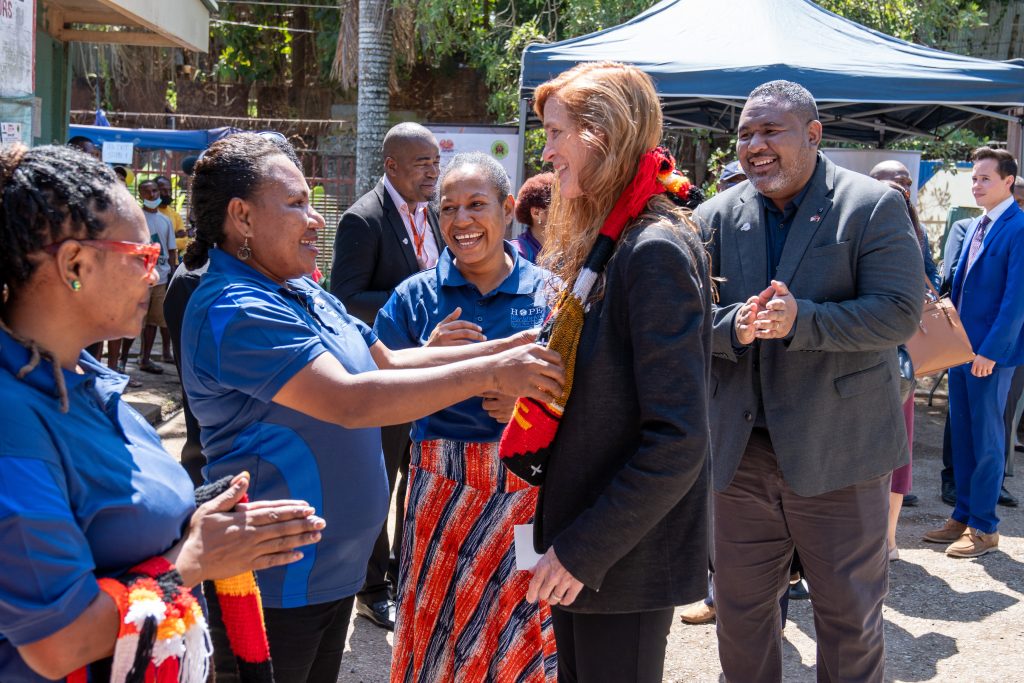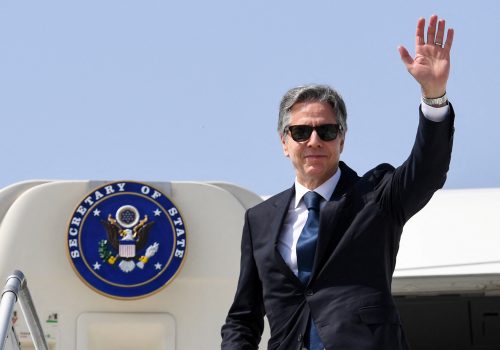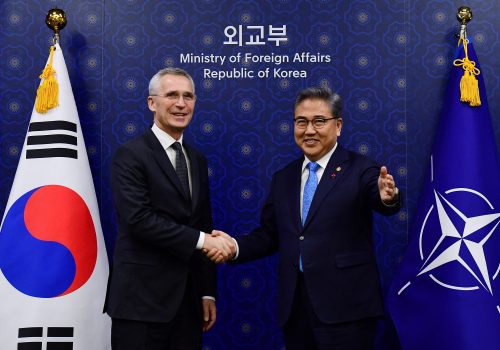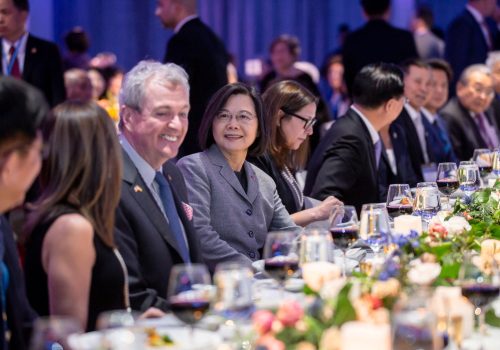As the Pacific Islands’ relevance to US foreign policy continues to grow, so does the number of high-level visits to the region by US officials. Over the past three months alone, Secretary of State Antony Blinken, Secretary of Defense Lloyd Austin, Secretary of the Interior Deb Haaland, and Second Gentleman Doug Emhoff collectively traveled to Micronesia, Papua New Guinea, Palau, Samoa, and Tonga.
US Agency for International Development (USAID) Administrator Samantha Power’s visit this week to Papua New Guinea and Fiji is another example of this trend. Showing up matters everywhere, but especially so in the Pacific Islands, where each successive high-level interaction helps build confidence in the United States as a reliable partner that can deliver outcomes beneficial to Pacific nations’ development and security needs.
Power’s visit shows that the United States gets the importance of soft power to succeeding in the region. It also helps dispel lingering skepticism among Pacific Island leaders and officials about US staying power in the region. This skepticism persists not just because US President Joe Biden abruptly canceled his May trip to Papua New Guinea; it’s more so because the United States pulled up its diplomatic stakes at the end of the Cold War, only to return in recent years when concerns about geopolitical competition with the People’s Republic of China (PRC) took hold in Washington.
The United States’ post-Cold War absence—and eventual return
As in other parts of the world, the United States reduced its diplomatic footprint in the Pacific Islands during the 1990s. These far-flung islands became out of sight, out of mind for US policymakers, who were focused on Europe and the newly independent post-Soviet states. Following the attacks of September 11, 2001, the United States turned to the Middle East and concentrated its attention there for the better part of two decades.
In lieu of the United States, the PRC stepped into the breach and exploited Washington’s relative absence from the Pacific. Upon establishing the China-Pacific Islands Countries Economic Development and Cooperation Forum in 2006, the PRC increased development aid and financing to the region, with a focus on tangible economic and infrastructure needs. It also ramped up high-level diplomacy—which it excels at—and showered Pacific leaders with pomp and circumstance that they tended not to receive elsewhere.
Beijing’s efforts paid off, and it progressively amassed clout at the expense of the United States and its regional allies and partners, such as Australia, which has long been active in the region. But as geopolitical rivalry heated up, Washington turned its attention back toward the Pacific Islands, notably accelerating its engagement in the late 2010s. Last year’s announcement of a security agreement between the PRC and the Solomon Islands was a Sputnik moment of sorts in Washington, catalyzing newfound interest in the region from US policymakers.
Soft power and the United States’ regional strategy
While in Papua New Guinea and Fiji, Power announced a ramped-up USAID regional presence, including the formal elevation of its mission in Port Moresby and re-establishment of its regional mission in Suva. In addition, Power announced new funding for development programs in Papua New Guinea. Through these announcements, she signaled the centrality of soft power to the United States’ regional strategy—and that Washington is making a conscious effort to meet the development needs of Pacific Islanders.
In the Pacific Islands, soft power isn’t viewed as distinct from hard power; in fact, they’re viewed as one and the same. Issues like economic growth and human development are seen as security issues, as evidenced by the Boe Declaration, which was adopted during the 2018 Pacific islands Forum in Nauru. The declaration calls for “an expanded concept of security inclusive of human security, humanitarian assistance, prioritizing environmental security, and regional cooperation in building resilience to disasters and climate change.”
Thus, a comprehensive regional strategy cannot be just about hard power. To succeed, the United States needs to use its full suite of civilian and defense tools—what former US Secretary of Defense Robert Gates described as a “symphony of power”—to advance an agenda that bolsters the region’s prosperity and resilience. This approach is reflected in the Biden administration’s Pacific Partnership Strategy, which was released during the September 2022 US-Pacific Island Country Summit at the White House.
The United States’ path forward
The United States is following through on commitments made and showing that it’s in the region to stay. Along with USAID’s stepped-up presence, Washington has opened new embassies in the Solomon Islands and Tonga; renewed Compacts of Free Association with Micronesia and Palau (pending congressional approval); inked a defense agreement with Papua New Guinea (pending parliamentary approval); and more. It should continue pushing forward with these efforts, especially in the run-up to the leader’s summit scheduled for September, and it should work with allies and partners to maximize impact.
Crucially, the United States is also making progress on promised funding for development programs. This includes the Economic Assistance Agreement (EAA) associated with the South Pacific Tuna Treaty, which supports fisheries’ economic development, collaboration on climate resilience, the blue economy, and maritime security—all of which are crucial issues for the Pacific Islands.
The State Department requested $60 million for the first year of the proposed ten-year, $600 million EAA package in its fiscal year (FY) 2024 budget request, and the House Appropriations Committee included the same amount in its FY 2024 bill that funds the State Department. While FY 2024 appropriations bills have yet to be signed into law, this funding seems on course for inclusion.
Finally, the United States is also making headway in showing the region that it isn’t engaged only because of geopolitical competition with China. As I wrote last month, the United States needs to think beyond China in the Pacific Islands; if statements and remarks by US officials during recent visits are any indication, they are doing exactly that. Geopolitics is important, but the United States’ relations with the region ultimately need to be about much more.
Parker Novak is a nonresident fellow with the Atlantic Council’s Indo-Pacific Security Initiative and Global China Hub. He specializes in Southeast Asia and the Pacific Islands and previously served as the country director for a nongovernmental organization in Indonesia and Timor-Leste. He is also the deputy government relations director for the US Global Leadership Coalition, which advocates for a stronger international affairs budget. Views expressed in this piece are the author’s own and do not reflect those of his employer.
Further reading
Tue, Jul 25, 2023
As Blinken visits Tonga, the US needs to think beyond China in the Pacific Islands
New Atlanticist By Parker Novak
Geopolitics is important, but Washington’s relations with the strategically located region need to be about more than competition with Beijing.
Mon, Feb 6, 2023
NATO is entering a new phase in the Indo-Pacific
New Atlanticist By
NATO Secretary General Jens Stoltenberg's visit to Japan and South Korea trip was striking both for its timing and for its messaging shift on China.
Mon, Apr 3, 2023
Don’t let Beijing define the narrative of Taiwan’s relations with the world
New Atlanticist By Markus Garlauskas
As Taiwan President Tsai Ing-wen stops in the United States, Beijing is trying to paint reasonable, routine, and restrained actions as risky, worrisome, and escalatory.
Image: USAID Administrator Samantha Power visits Papua New Guinea on August 14, 2023. Courtesy: USAID.



